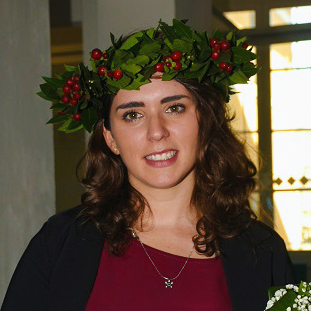THE MYTH OF ARIADNE, FROM YESTERDAY TO TODAY
5 min read
Everyone knows the myth of Ariadne, of the Minotaur and Theseus, of the labyrinth and the skein, and we all know its Greek origin. However, in Latin the tradition of the myth of Ariadne has continued for a long time, creating also what today we would call noteworthy spin-offs.
The Myth has its own antecedent. It all began in Crete, from the union between Zeus and Europa, from which three children were born, including Minos, who after the marriage of his mother with Asterion, king of Crete, became the first heir to the throne, being the marriage between the two sterile. To claim the throne of Crete and demonstrate how this was the will of the Gods, Minos prayed to Poseidon to send him a bull, sacred animal to the Cretans, as a symbol of appreciation, promising to sacrifice it later.
After obtaining the throne, Minos was so enraptured by this bull, that he decided not to kill it, sacrificing another in its place. Poseidon then, for the affront suffered, punished Minos by making his wife, Pasiphae, fall in love with the bull, so that she had a wooden structure built by Daedalus (yes, just the one of the labyrinth!) So that he could have a complete relationship with the bull. From this relationship was born the Minotaur. Always Daedalus, was charged, therefore, to build a labyrinth to hide the monstrous fruit of that zoophilic union.
So, when does Theseus arrive?
It is necessary to go back of some years when, near Athens, in the period in which they were held the Panathenaic games (similar to the Olympiads, but concerning Panathenaic festivities), where, for a long time, continued to win the Cretans, in virtue of one of their extraordinary athlete: Androgeo, son of Minos (and therefore brother of Ariadne). The king of Athens, Aegeus, livid with anger for the prowess of the Cretan athlete, made him bring a cup full of poison and that he was killed. Then the Gods, who held Androgeo very dear, became very angry and decided to punish the city of Athens, with storms of poisonous darts and diseases and plagues.
The Athenians, by asking the oracle, discovered that they had to come to terms with Minos to make sure that all that disaster ended. From here, every year, on the day of the death of Androgeus, the Athenians would have to send seven boys and seven girls in sacrifice in Crete, because they were given to the Minotaur. At this point, Theseus, son of Aegeus, finally arrives: one day he decided to leave with the boys, but not to be sacrificed, but to return victorious.
The rest of the story, we all know it.
There are conflicting opinions on why, after the escape from Crete, Theseus left Ariadne on the island of Naxos (today we say “in the lurch”, when we leave someone “walking” without telling him anything: this way of saying comes from the myth of Ariadne who was left “in (N)ace!”). Some think Theseus already had another lover, such Egle; others think it would have been a scandal for the son of the king of Athens to bring there the daughter of the one who had caused all this pain for many years. And yet others say that Dionysus had appeared in a dream to Theseus and told him to leave. However the matter may be, Ariadne found herself alone and wept bitter tears, invoking the harpies against Theseus.
For her there was a happy ending, with the marriage with Dionysus, while for Theseus it was much worse. In fact, in the way out the father had given to a helmsman some sails to expose if Theseus had come back alive. Unfortunately, it slipped his mind to the young man and he showed up without those sails. The father, seeing from the tower the ship come back without those sails, committed suicide (it is said that so was born the Aegean Sea).
In Latin literature, Catullus took up this myth in his carmina docta, precisely in carme 64. Due to being linked by the same condition of abandonment to the protagonist of the myth, he was able to make a pathetic and painful description of her lament. After him, Ariadne will become almost literary topos of the seduced and abandoned woman. From here in fact will be born figures like Dido, in the Aeneid of Virgil, where in the role of Theseus we have Aeneas.
Propertius also continued with this theme, putting Ariadne as a model of elegiac woman par excellence, comparing her to his lover, Cynthia.
The potential of Ariadne as a model is seen, however, mainly in Ovid. In the Eroides, an imaginary collection of letters of abandoned heroines, Ariadne takes the floor directly and writes to Theseus. He complains and demonstrates their pain with a very deep psychological touch. Ovid will return to this figure also in the Ars Amatoria, a manual that teaches men to seduce women. There he dwells, however, on the arrival of Dionysus, rather than the lament of Ariadne. In the Fasti, however, returns on the Myth showing an unprecedented Ariadne. It is seen jealous, because she doubts the fidelity of Dionysus, believing that these trying to conquer an Indian princess. Then, here she replicates the complaint made for Theseus, with the difference that Dionysus comes to calm her.
As time goes by, even Petrarch will talk about Ariadne, but it will be Boccaccio who will give an interesting image of her. He defines her as an alcoholic and a nymphomaniac, stating Theseus escaped from Naxos with Ariadne’s sister, Phaedra, leaving her in a wine-induced sleep.
Throughout the Renaissance and until the 18th century, Ariadne appears several times in painting, often for the representations concerning the arrival of Dionysus.
In the twentieth century, however, is revalued a figure that until now had been ignored: the Minotaur. Together with this, the concept of labyrinth is also given great importance, as in Borges’ Aleph.
The suggestions of the myth continue to be strong even today. Probably this occurs because of the strength with which it was described, from the beginning, a female figure such as Ariadne. Maybe this is because the concept of labyrinth has always created fear and at the same time interest. It is interesting to note how this myth can be considered one of the possible red threads between the Latin past and modernity.

Ciao, mi chiamo Martina e sono laureata in Lingue. Le mie passioni principali gravitavano da sempre intorno a letteratura, cultura, linguistica, viaggi, così ho deciso di intraprendere la strada della traduzione, specializzandomi grazie ad un Master. Adoro leggere, pratico beachvolley e amo stare a contatto con la natura.





